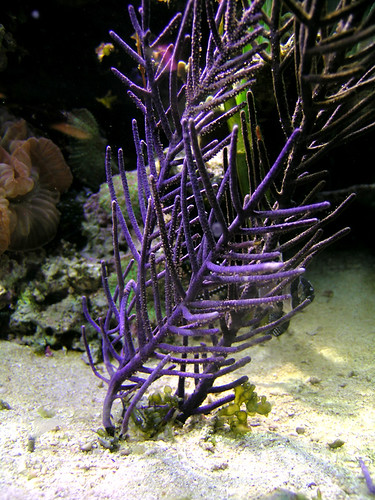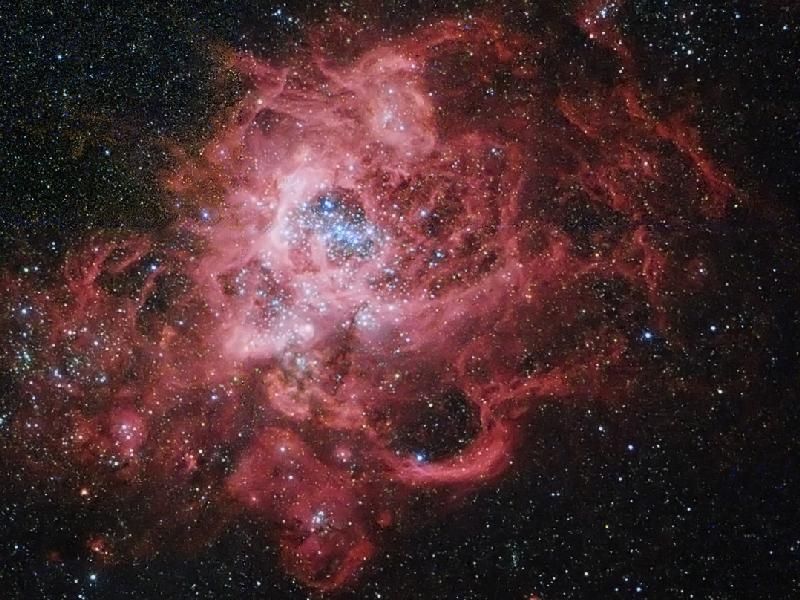Here we are once again. Monday is upon us and the time for science talk is here. Time to brighten your day with selections from science sites across the globe. New discoveries, new takes on old knowledge, and other bits of news are all available for the perusing in today's information world. Today's tidbits include mussel glue inspires blood vessel glue, ancient red dye powers new 'green' battery, the first microquasar beyond the Milky Way found in a neighboring galaxy, tropical montane cloud forests drink water through their leaves, and our early ancestors ate tropical grasses.
Pull up that comfy chair and grab a spot on the porch. There is always plenty of room for everyone. Another session of Dr. Possum's science education, entertainment, and potluck discussion is set to begin.
Featured Stories
The neverending search for drugs and applications took a new turn with the report of mussel glue, the stuff that mussels use to adhere to surfaces, and the possibility of use for blood vessel repair.
The gel’s “sheer strength” could shore up weakened vessel walls at risk of rupturing – much like the way putty can fill in dents in a wall...
By forming a stable barrier between blood and the vessel walls, the gel could also prevent the inflammation that typically occurs when a stent is inserted to widen a narrowed artery or vein; that inflammation often counteracts the opening of the vessel that the stent was intended to achieve.
Purpurin, a dye extracted from the roots of the rose madder and once used to produce fiery red dyes, has chemical properties which may one day power a battery which uses far less rare elements than today's Li-ion batteries.
...biologically based color molecules, like purpurin and its relatives, seem pre-adapted to act as a battery’s electrode. In the case of purpurin, the molecule’s six-membered (aromatic) rings are festooned with carbonyl and hydroxyl groups adept at passing electrons back and forth, just as traditional electrodes do...
Moreover, growing madder or other biomass crops to make batteries would soak up carbon dioxide and eliminate the disposal problem – without its toxic components, a lithium-ion battery could be thrown away.
With ongoing investigation into our universe comes news of the first
microquasar, a black hole devouring material from a companion star, found outside the Milky Way.
The object, pumping out X-rays and bright bursts of radio waves, was found in the Andromeda Galaxy, 2.5 million light-years from Earth.
The discovery, scientists say, gives hope that more such objects may be found in nearby galaxies, providing them with opportunities to make detailed studies that will unravel the mystery of just how these enigmatic powerhouses—and their big brothers—actually work.
The effects are widespread and continue to be found to be more detrimental than we might expect.
Tropical montane cloud forests depend on clouds for water. The clouds are now threatened by climate change.
In tropical montane cloud forests, leaves are constantly bathed in clouds, making them wet. The leaves of the most common cloud forest trees drink this cloud water when water from the soil just isn’t enough.
As a result of climate change those clouds are disappearing.
Early human ancestors (as long as 3.5 million years ago) survived by eating tropical grasses, not the nuts and grains consumed by later populations.
The finding is significant in signalling how early humans were able to survive in open landscapes with few trees, rather than sticking only to types of terrain containing many trees. This allowed them to move out of the earliest ancestral forests or denser woodlands, and occupy and exploit new environments much farther afield.
The fossils of the three individuals, ranging between three million and 3.5 million years old, originate from two sites in the Djurab desert. Today this is a dry, hyper-arid environment near the ancient Bahr el Ghazal channel which links the southern and northern Lake Chad sub-basins. However, in their paper the authors observe that at the time when Australopithecus bahrelghazali roamed, the area would have had reeds and sedges growing around a network of shallow lakes, with floodplains and wooded grasslands beyond.
Knucklehead's Photo of the Week
Purple Penmanship

©Knucklehead, all rights reserved, presented by permission. (Click on the image to see more in the same series.)
Other Worthy Stories of the Week
Mining ancient ores for clues to early life
Nearby star, Vega, much older than thought
Resurrection of extinct yeast enzymes reveals evolutionary strategy for the invention of new functions
Ant and termite colonies unearth gold
Scary news for corals--from the Ice Age
First cheese making in Europe--6th millenium BCE
Cassini spots mini Nile river on Saturn moon, Titan
Replacing damaged bone with implants based on wood
Fecal samples from archeological sites reveal evolution of human gut bacteria
Views of glaciers seen from space Pictures, pictures.
Asteroid Toutatis slowly tumbles by Earth
Remarkable symmetry in black hole jets
Three new species of venomous primates identified
Your Christmas tree and its genome have remained very much the same over the last 100 million years
For even more science news:
General Science Collectors:
Alpha-Galileo
BBC News Science and Environment
Eureka Science News
LiveScience
New Scientist
PhysOrg.com
SciDev.net
Science/AAAS
Science Alert
Science Centric
Science Daily
Scientific American
Space Daily
Blogs:
A Few Things Ill Considered Techie and Science News
Cantauri Dreams space exploration
Coctail Party Physics Physics with a twist.
Deep Sea News marine biology
List of Geoscience Blogs
Science20.com
ScienceBlogs
Space Review
Science Insider
Scientific Blogging.
Space.com
Techonology Review
Tetrapod Zoologyvertebrate paleontology
Wired News
Science RSS Feed: Medworm
The Skeptics Guide to the Universe--a combination of hard science and debunking crap
At Daily Kos:
This Week in Science by DarkSyde
Overnight News Digest:Science Saturday by Neon Vincent. OND tech Thursday by rfall.
Pique the Geek by Translator Sunday evenings about 9 Eastern time
All diaries with the DK GreenRoots Tag.
All diaries with the eKos Tag
A More Ancient World by matching mole
Astro Kos
SciTech at Dkos.
Sunday Science Videos by palantir
NASA picture of the day. For more see the NASA image gallery or the Astronomy Picture of the Day Archive

M33, NASA, Public Domain


